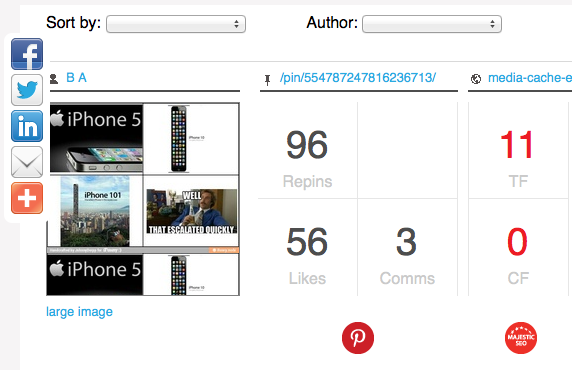[caption id="attachment_5190" align="aligncenter" width="572"]

Pinalytics data-mines Pinterest for pins, boards, and people associated with inputted keywords; the results can be sorted by various metrics.[/caption] Given the rising interest in data-mining every last bit of insight out of social networks—Tumblr recently named a
“preferred analytics provider,” and large IT vendors such as Oracle and Salesforce have introduced data tools for Facebook and Twitter—it was perhaps only a matter of time before analytics platforms appeared for Pinterest. For those not up on their social networks, Pinterest lets users set up personalized “boards” on which they can share images, known as “pins.” By virtue of being heavily image-centric, Pinterest stands apart from Twitter and other social networks that place more emphasis on text; its burgeoning popularity also makes it a potential data goldmine for organizations. U.K.-based
Pinalytics advertises itself as a “social media tool to help you find, track and evaluate content and interactions on Pinterest.” (Hat-tip to
The Next Web for first noting its existence.) The software itself is easy to use, searching the Pinterest network for any pins, boards and people associated with the keywords inputted into a search bar. Users can sort the results by comments, repins, likes, and other metrics. Pinalytics also offers the ability to see how a piece of Pinterest content spreads across other social networks, including Facebook, Google+, Reddit, LinkedIn, Twitter, and Digg. For example, the user could input the term “iPhone 5” into Pinalytics’ search bar, then see that the top iPhone 5 “pin” earned 397 repins, 219 Pinterest likes, 31 comments, six Tweets, two Facebook shares, and five Google+ +1s:

Pinalytics isn’t the only piece of Pinterest mining equipment on the market. For example,
Pinfluencer offers some granular insights into pins and boards, including which ones drive e-commerce and engage users the most. Given Pinterest’s growth—research firm comScore estimated its growth between May 2011 and May 2012 at 4377 percent—it’s a near certainty that other analytics platforms for the network will make their debut; the bigger question is whether the larger tech giants will begin snatching up those platforms and integrating them into their own analytics offerings.
Images: Pinalytics  Pinalytics data-mines Pinterest for pins, boards, and people associated with inputted keywords; the results can be sorted by various metrics.[/caption] Given the rising interest in data-mining every last bit of insight out of social networks—Tumblr recently named a “preferred analytics provider,” and large IT vendors such as Oracle and Salesforce have introduced data tools for Facebook and Twitter—it was perhaps only a matter of time before analytics platforms appeared for Pinterest. For those not up on their social networks, Pinterest lets users set up personalized “boards” on which they can share images, known as “pins.” By virtue of being heavily image-centric, Pinterest stands apart from Twitter and other social networks that place more emphasis on text; its burgeoning popularity also makes it a potential data goldmine for organizations. U.K.-based Pinalytics advertises itself as a “social media tool to help you find, track and evaluate content and interactions on Pinterest.” (Hat-tip to The Next Web for first noting its existence.) The software itself is easy to use, searching the Pinterest network for any pins, boards and people associated with the keywords inputted into a search bar. Users can sort the results by comments, repins, likes, and other metrics. Pinalytics also offers the ability to see how a piece of Pinterest content spreads across other social networks, including Facebook, Google+, Reddit, LinkedIn, Twitter, and Digg. For example, the user could input the term “iPhone 5” into Pinalytics’ search bar, then see that the top iPhone 5 “pin” earned 397 repins, 219 Pinterest likes, 31 comments, six Tweets, two Facebook shares, and five Google+ +1s:
Pinalytics data-mines Pinterest for pins, boards, and people associated with inputted keywords; the results can be sorted by various metrics.[/caption] Given the rising interest in data-mining every last bit of insight out of social networks—Tumblr recently named a “preferred analytics provider,” and large IT vendors such as Oracle and Salesforce have introduced data tools for Facebook and Twitter—it was perhaps only a matter of time before analytics platforms appeared for Pinterest. For those not up on their social networks, Pinterest lets users set up personalized “boards” on which they can share images, known as “pins.” By virtue of being heavily image-centric, Pinterest stands apart from Twitter and other social networks that place more emphasis on text; its burgeoning popularity also makes it a potential data goldmine for organizations. U.K.-based Pinalytics advertises itself as a “social media tool to help you find, track and evaluate content and interactions on Pinterest.” (Hat-tip to The Next Web for first noting its existence.) The software itself is easy to use, searching the Pinterest network for any pins, boards and people associated with the keywords inputted into a search bar. Users can sort the results by comments, repins, likes, and other metrics. Pinalytics also offers the ability to see how a piece of Pinterest content spreads across other social networks, including Facebook, Google+, Reddit, LinkedIn, Twitter, and Digg. For example, the user could input the term “iPhone 5” into Pinalytics’ search bar, then see that the top iPhone 5 “pin” earned 397 repins, 219 Pinterest likes, 31 comments, six Tweets, two Facebook shares, and five Google+ +1s:  Pinalytics isn’t the only piece of Pinterest mining equipment on the market. For example, Pinfluencer offers some granular insights into pins and boards, including which ones drive e-commerce and engage users the most. Given Pinterest’s growth—research firm comScore estimated its growth between May 2011 and May 2012 at 4377 percent—it’s a near certainty that other analytics platforms for the network will make their debut; the bigger question is whether the larger tech giants will begin snatching up those platforms and integrating them into their own analytics offerings. Images: Pinalytics
Pinalytics isn’t the only piece of Pinterest mining equipment on the market. For example, Pinfluencer offers some granular insights into pins and boards, including which ones drive e-commerce and engage users the most. Given Pinterest’s growth—research firm comScore estimated its growth between May 2011 and May 2012 at 4377 percent—it’s a near certainty that other analytics platforms for the network will make their debut; the bigger question is whether the larger tech giants will begin snatching up those platforms and integrating them into their own analytics offerings. Images: Pinalytics 